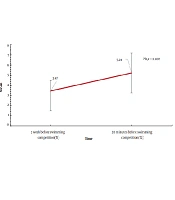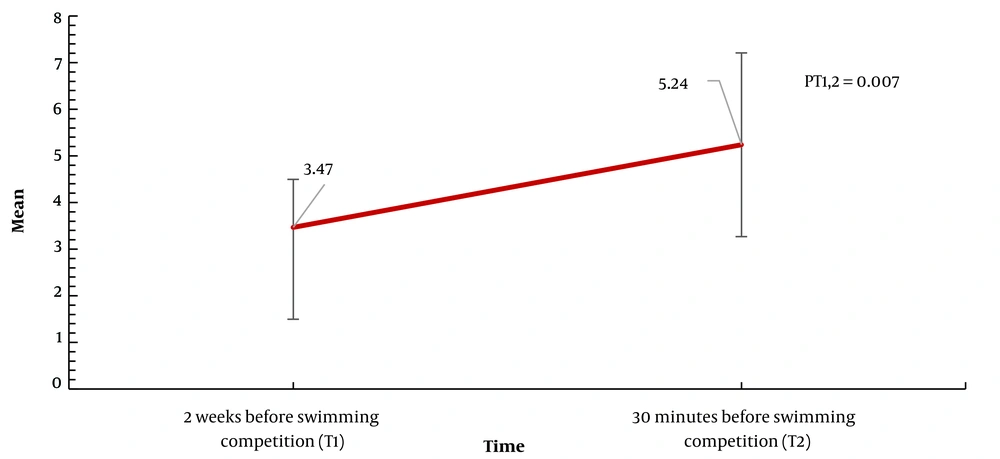1. Background
Cortisol, the principal glucocorticoid in humans, is known to play a major role in metabolism and immune function (1, 2). There are conflicting data on the effect of acute exercise on cortisol levels (3). Salivary cortisol concentration may be more appropriate to evaluate the activity of glucocorticoids than their serum concentration (3, 4). Competition can cause acute stress, and studies showed that acute exercise can raise cortisol levels in saliva (5, 6). Also, among female soccer players, saliva cortisol concentrations were higher ten minutes before the match compared to immediately after the match (5). Similarly, an elevated cortisol level was identified among young female gymnasts (7) and bicyclists (8).
Previous studies reported that exercise had no effect or negative effect on salivary cortisol levels. Talebi et al. (9) reported that resistance or powerful exercise significantly reduced the salivary cortisol levels in swimmers. On the contrary, Adesola (3) stated that salivary cortisol concentration did not change significantly among male children after exercise.
A study on male soccer players in Iran showed a rise in salivary cortisol levels after the first and second half of the competition compared to two hours before the match (10). Another study on female football players showed that cortisol decreased after the match and throughout the tournament, independently of the match outcome (11).
Athletes' anxiety is a physiological reaction to an imaginary or real threat. A positive stress is essential to attain the desired task. Upper levels of anxiety physically inhibit acts by creating muscle tension and impairing activity organization. However, the low performance of athletes was related to higher stress (12). Anxiety can increase corticosteroid hormones. In another study, pre-match cortisol concentrations were significantly associated with anxiety (13).
2. Objectives
This study aimed to examine the effect of competition on cortisol levels of saliva among young boy swimmers. Also, we determined the relationship between anxiety level and cortisol response in athletes 30 minutes before the swimming competition.
3. Methods
3.1. Ethics Statement
All parents of swimmers signed a written consent prior to the research. The study protocol was approved by the Institutional Review Board (IRB) of Jahrom University of Medical Sciences, Iran (JUMS.REC.1393.016).
3.2. Participants
In this study, we included 14 eligible elite boy swimmers aged 10 - 13 years. People who did strenuous exercise two weeks before the race, drank alcohol, used drugs, did doping, or had systemic diseases were excluded from the study. To collect data, parents were contacted and invited to participate in the study. Data were collected two weeks (as a base) and 30 minutes before the competition.
3.3. Sport Competition Anxiety Test (SCAT)
The sport competition anxiety test (SCAT) was completed before the competition. This test consists of 15 items, five of which (1, 4, 7, 10, and 13) are neutral questions with no scores. The items 2, 3, 5, 8, 9, 12, and 15 are scored based on a 3-point Likert scale (1 = hardly ever, 2 = sometimes, and 3 = often); the scoring is reversed for items 6 and 11. The SCAT was filled out immediately before the saliva sample collection in the dressing room. The score of competitive anxiety was calculated by summing the score of ten items, the score range of which is between 10 (low anxiety) and 30 (high anxiety).
A competitive score of less than 20 indicated a low level, and a score ≥ 21 indicated a high level of anxiety. Questions 2, 6, 8, 9, 11, 12, 14, and 15 assessed physical or somatic competitive anxiety levels, and questions 3 and 5 assessed cognitive competitive anxiety (14).
3.4. Saliva Cortisol Level Test
All subjects participated in the official swimming competition. Saliva collection was carried out at two different time points: Two weeks before the competition and 30 minutes before the competition. Two weeks before the swimming competition, the swimmers spent three days without any exercise under normal conditions, and their first baseline salivary cortisol was determined. The second saliva sample was taken 30 minutes before the swimming competition. To collect saliva, participants washed their mouths for a minute to remove any material like chlorine that might affect cortisol levels. Saliva samples were collected using standard methods so that swimmers were positioned vertically in the chair and bent their heads forward. The swimmers were then asked to produce saliva without deliberate effort that would not stimulate artificial saliva. After 4 minutes of salivation, the swimmers were asked to pour their saliva into a 20 ml plastic test tube. Immediately after collecting saliva, saliva samples were stored in a cool place and frozen in a freezer at -20°C. All saliva samples were kept at -20°C until analysis. Before analysis, the saliva samples were thawed and centrifuged for 15 min at 3000 rpm to remove mucus and cellular debris. The enzyme-linked immunosorbent assay (ELISA) technique was used to determine salivary free cortisol levels. Salivary cortisol has been shown to have a circadian rhythm (15). All testing sessions were performed simultaneously to avoid any confounding effects due to variations in circadian rhythm (8:30 a.m.).
3.5. Statistical Analysis
To analyze the data, SPSS software (version 20.0) was used. Quantitative data were reported as mean and standard deviation. A paired t-test examined the difference in salivary cortisol concentrations between basal (two weeks before the competition) and pre-competition (30 minutes before the competition) cortisol levels. Student t-test was used to compare the cortisol level of subjects with low and high anxiety levels. We used linear regression to evaluate salivary cortisol and anxiety levels. A P-value less than 0.05 was considered as statistically significant.
4. Results
We recorded the participants' data, including age (10 - 13 years), weight (35 - 62 kg), height (141 - 167 cm), and body mass index (BMI) (17.15 - 22.3 kg/m2). Salivary cortisol concentration was significantly higher 30 minutes before the competition compared to two weeks before the competition (P = 0.007) (Table 1 and Figure 1).
| Parameter | Mean ± SD | Minimum | Maximum |
|---|---|---|---|
| Cortisol level (µg/dL) 2 weeks before competition | 3.47 ± 1.03 | 1.26 | 4.91 |
| Cortisol level (µg/dL) 30 minutes before competition | 5.24 ± 1.97 | 3.1 | 8.99 |
| Difference in cortisol levels (µg/dL) 2 weeks and 30 minutes before competition | 1.77 ± 2.08 | 0.02 | 6.66 |
| P-value a | 0.007 |
The Mean Salivary Cortisol Levels 2 Weeks and 30 Minutes Before the Competition
In all subjects, the cortisol levels 30 minutes before the competition increased by 51% compared to two weeks before the competition. Eight participants showed an intensified saliva cortisol levels under 100%. However, a more than twelve-fold increase in cortisol levels was observed in two people. The anxiety score in all subjects 30 minutes before the competition was equal to or greater than 15. Thus, all participants had pre-competition anxiety (Table 2). According to the results of SCAT, 11 (78.6%) swimmers had a low level of anxiety. No significant differences were observed between different measures of saliva cortisol for low SCAT anxiety and high SCAT anxiety (5.11 ± 1.78. vs. 5.69 ± 3.01, P = 0.672). The saliva cortisol concentration was not significantly related to SCAT, somatic, and cognitive anxiety (Table 3).
| Variable and Category | Mean ± SD | Minimum | Maximum |
|---|---|---|---|
| Anxiety score 30 minutes before competition | |||
| Total | 17.93 ± 3.25 | 15 | 26 |
| Somatic or physical | 14.71 ± 2.95 | 12 | 22 |
| Cognitive | 3.22 ± 0.98 | 2 | 5 |
The Mean Anxiety Score 30 Minutes Before the Competition
| Variables | R Square | B Coefficient | P-Value |
|---|---|---|---|
| SCAT anxiety | 0.058 | 0.147 | 0.405 |
| Somatic anxiety | 0.074 | 0.181 | 0.348 |
| Cognitive anxiety | 0.001 | -0.031 | 0.953 |
The Results of Linear Regression Analysis on Saliva Cortisol Levels According to SCAT, Somatic, and Cognitive Anxiety a
5. Discussion
This study determined the difference between cortisol levels two weeks before swimming competition and 30 minutes before the competition. The results of this study showed that 21.4% of the participants had anxiety, and salivary cortisol levels 30 minutes before the competition increased by 51% compared to two weeks before the competition. This might be a typical physiological result related to stress response during competition.
The elevation in pre-competition cortisol concentration of saliva is consistent with some previous studies establishing an increase in saliva cortisol level in elite athletes in response to competition exercises (16, 17). Previous investigations confirmed that salivary cortisol concentration during acute exercise significantly increased compared to before exercise (18-21). The cortisol level peaked at 14 minutes but was slightly higher 24 hours after exercise than those measured before exercise (18). Also, the salivary cortisol level was higher in competitive than non-competitive athletes immediately after the isokinetic exercise test (22) and immediately following the high-intensity exercise session (23). Similarly, 35 female football players (5) and female volleyball players (1) had elevated cortisol concentrations in saliva after the competition. On the contrary, no change in salivary cortisol level was identified following repeated bouts of supramaximal cycling in 19 healthy females aged 15 - 16 years (24). Also, similar results were confirmed in the swimmers (25) and professional athletes (26). Other studies showed that salivary cortisol levels increased insignificantly (3, 27).
In contrast to our findings, some previous studies reported a significant decline in salivary cortisol levels after resistance exercise protocols (28). Talebi et al. (9) and Dimitriou et al. (29) identified a significant decline in salivary cortisol levels in swimmers following intense exercise.
The increased salivary cortisol in our study may be a consequence of physical exercise, the psychosocial influence of race, or a combination of two. Competition is an acute stress that may produce anxiety before or during competition. Some studies showed increased anxiety before and during exercise (30, 31). Anxiety and stress before or during the competition were the most important external elements that directly contribute to motivation and secretion of cortisol.
The reason for the discrepancy between the results of this study and other studies may be due to different exercises, acute exercise protocols, and whether or not the food was ingested before exercise. Also, we determined salivary cortisol levels at rest (2 weeks) and 30 minutes before competition, whereas others determined saliva cortisol levels before and during or after the competition. McGuigan et al. (23) found a significant difference in salivary cortisol levels (145%) between the low-intensity and high-intensity exercise sessions immediately after exercise. They also suggested that low-intensity exercise did not significantly alter salivary cortisol concentrations.
Our results showed that all participants had at least a 25% SCAT anxiety score and salivary cortisol concentration increased by 51% above resting level 30 minutes before the competition. Strahler et al. evaluate 17 martial artists and reported similar results (32). Our study did not confirm a significant linear relationship between pre-competition SCAT anxiety and salivary concentration of cortisol. Nonetheless, in a survey conducted by Arruda et al. (13), somatic anxiety was significantly correlated to pre-match cortisol (rho = -0.69; P = 0.00).
Our study had some limitations. First, the sample size of the study was small. Second, we had no control group. Third, we could not control other causes of stress and anxiety.
5.1. Conclusions
The swimming competition was accompanied by elevated salivary cortisol concentration among elite boy swimmers. Also, the competition caused high SCAT anxiety score. However, salivary cortisol level was not related to SCAT anxiety linearly.

